Wood species
On the following pages I try to give a - really short - overview of the woods I use.
Usually all woods used come "from the neighbour's garden" and are stored and dried by me until I can use and carve them. Sometimes there are special rarities, about which I have found only insufficient information, if at all. For example rhododendron or rose root tuber.
The only wood I buy is linden, as I have not found a source in my area yet.
For some of my works I even use glued wood - I will not describe it here. It is a very interesting material. It is a very soft, long fibered wood with a beautiful grain. But see for yourself in the "My works" section.
Amerikanisches Mahagoni (Swietenia macrophylla) wird auch echtes Mahagoni genannt und kommt vor in Mittelamerika und dem tropischen Südamerika.
Dieser Baum ist anfangs immergrün. Erst später wird wirft er sein Laub ab. Der baum wird bis zu 70m hoch und sein Stamm erreicht einen Durchmesser von bis zu 3,5m.
Echtes Mahagoni ist ziemlich leicht und trotzdem recht fest und extrem widerstandsfähig. Es arbeitet und schwindet kaum und hat ein sehr gutes Stehvermögen. Bei der Trockung kommt es selten zu Rissbildung.
Außerdem hat es sehr gute Eigenschaften als Tonholz und wird auch gerne im Möbelbau (Volholz oder Furnier) oder bei Drechselarbeiten verwendet.
Es soll sehr widerstandfähig gegenüber Pilzen und Insekten sein.
Das Splintholz ist grau-braun bis grau-gelb, hat jedoch nur eine geringe Breite und hebt sich deutlich vom rot-braunen bis hell-braunen Kernholz ab. beim längs aufgeschnittenen Holz kann man zahlreiche „Spiegel" erkennen.
Swietenia macrophylla ist die Art mit der größten wirtschaftlichen Bedeutung, weil sie das größte Verbreitungsgebiet hat. Es gibt aber noch etliche weitere Arten wie Khaya (Khaya spp.; afrikanisches Mahagoni), Sipo-Mahagoni (Entandrophragma utile), Kosipo (Entandrophragma candollei Harms.), Sapeli (Entandrophragma cylindricum) und Tiama (Entandrophragma angolense) die angeboten werden. Allerdings handelt es sich hierbei nicht um echtes Mahagoni, nur um Ersatz.
Da das optische Erscheinungsbild erst nach einer Behandlung mit Lack, Öl und/oder Wachs voll zur Geltung kommt, sollte darauf
Wegen der großen Nachfrage kommt es oft zu "Engpässen". Hinzukommt, dass es sich um einen langsam wachsenden Baum handelt. Dadurch sind viele Bestände betreits vollständig geplündert.
In der Liste der gefährdeten Arten der IUCN wurde echtes Mahagoni 1998 als „vulnerable" = „gefährdet" bewertet. Der Handel mit amerikanischem Mahagoni ist durch das Washingtoner Artenschutzabkommen beschränkt. Die Einfuhr bedarf der Genehmigung durch das Bundesamt für Naturschutz.
When we talk about basswood, usually the wood of the small-leaved lime (Tilia cordata) or the Tilia platyphyllos is meant. there is alos ahybrid of those two, the "Holland lime tree" (Tilia x europeae)
Between the basswood species are only small differences. Therefore, both are usually treated the same.
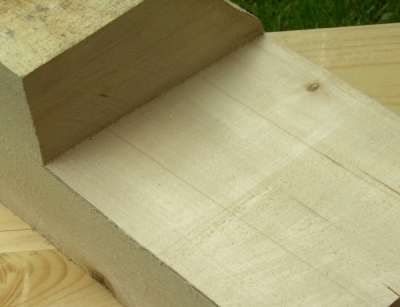 The basswood is relatively soft and moderate. It is tough, elastic and slightly less firm. It is highly evanescent. However does not "work" as othe wood does.
The basswood is relatively soft and moderate. It is tough, elastic and slightly less firm. It is highly evanescent. However does not "work" as othe wood does.
Annual rings are visible only dimly. Basswood has a light heartwood, which differs little from the sapwood. The basswood is lightly colored. It changes from white to yellowish, sometimes it has a reddish or brownish impact. Carved surfaces have a beautiful shine.
Basswood is easy to carve. The surfaces can be sabded and polished very well. Underdirect sunlight, it tends to turn yellow and in contact with iron there in connection with water it turns to gray.
Basswood is probably one of the most popular wood for carving, because it can be processed very well and it is easy tol carve.
The Cherry or Sweer-cherry (Prunus avium) is a very fine structured wood. It is moderately hard, moderately heavy. It is considered to be strong and tough.
Sapwood and heartwood of cherry tree can be quite clearly distinguished: The narrow sapwood is yellowish-white, but can also be reddish white. The heartwood has a reddish yellow to reddish-brown. The annual rings are clearly visible, the result is a typical fine drawing. Exposure to light, it may darken and take on a very strong reddish brown to pale golden-yellow hue.
The wood is mainly used for furniture and for turning and carving. It is easy to clean, to carve and to edit. It is also very good to polish.
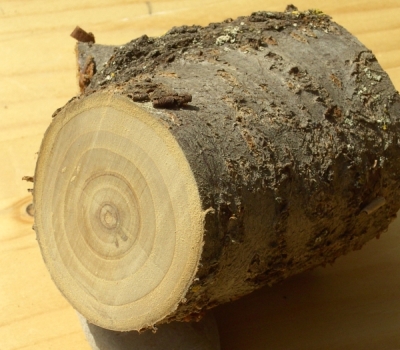
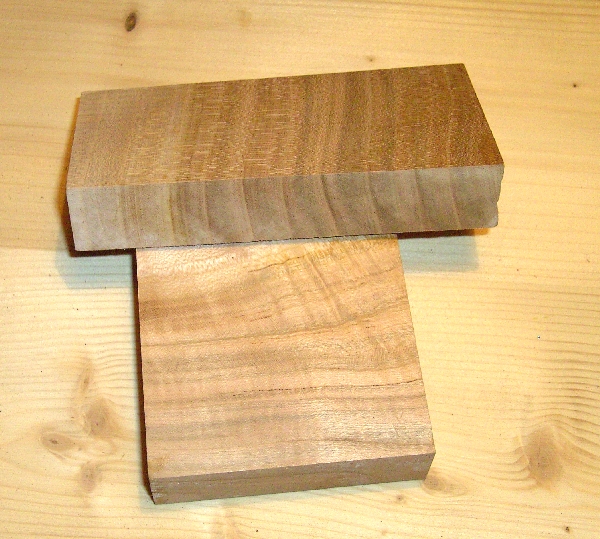
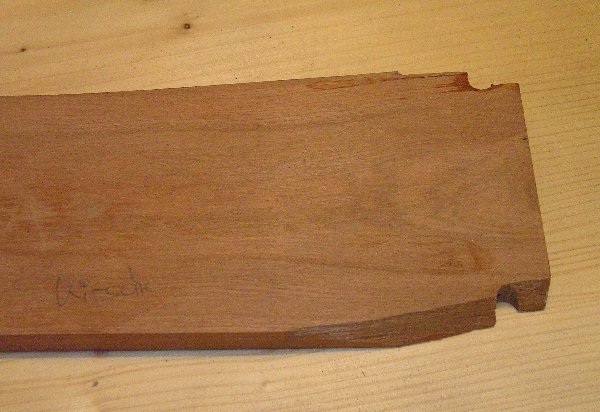
Hazelnut (Corrylus avellana) is a moderate hard wood and it is tough.between heartwood and sapwood is no big difference and it is easy to carve.
Hazelnut is used to bullt bows.
Auf Grund seiner zähelastischen Eigenschaften lassen sich aus Haselnuss auch hervorragende Stiele für Werkzeuge und Waffen machen. Mit dünnen Ruten lassen sich sogar Körbe flechten.
Früher nutzte man diese Gerten für Flechtzäune, Vogelschlingen, Ausklopfstäbe und Korbbügel, stärkere Äste für Spazierstöcke und Armbrustbögen. Das wenig dauerhafte Holz diente zu Drechsler- und Tischlerarbeiten und wurde als Klärspäne in der Bier- und Essigfabrikation sowie zur Herstellung von schwarzem Schießpulver und weicher Zeichenkohle verwendet. Im alten Volksglauben gilt ein Zweig der Haselnuß als Zauber und Unheil abwehrendes Mittel.
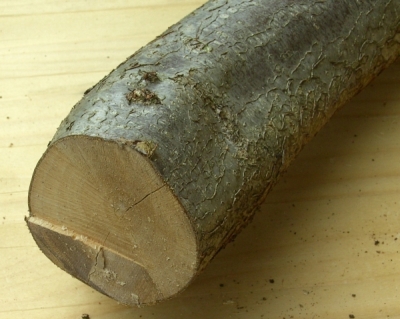
The Hornbeam (Carpinus betulus) is also called European beech. The name derives from the Old High German word 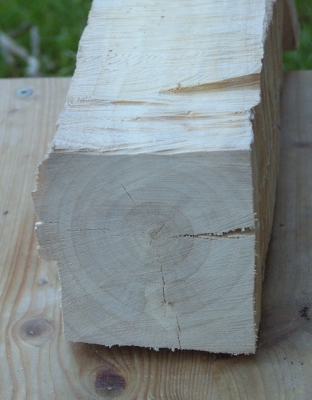 "Haganbouche". The word refers to the fact that the tree "accepts" to be cut easy without an problems. The second part of the name refers to the similarity to the European beech (Fagus salvatica) - but the hornbeam is not closely related to the European beech.
"Haganbouche". The word refers to the fact that the tree "accepts" to be cut easy without an problems. The second part of the name refers to the similarity to the European beech (Fagus salvatica) - but the hornbeam is not closely related to the European beech.
The wood of the hornbeam is whitish. Between sapwood and heartwood is no big differences in color. The annual rings are very difficult to see and the wood looks very smooth. The wood of the hornbeam is the heaviest wood of native tree species. Accordingly, it is very dense and hard. Furthermore, it is considered to be tough and elastic. Its tensile strength is still greater than that of the oak. However, the wood shrinks quite strong and tends to crack.
The wood is a heavy and very hard. It is even harder than that of beech or oak. therefore it is also known as iron wood or iron tree. Because of its hardness of the wood is used where high stresses appear. Today, the wood plays a quite big role when building pianos. Plane soles, and other tools for butchers chopping blocks or Billiardqueues are more typical examples.
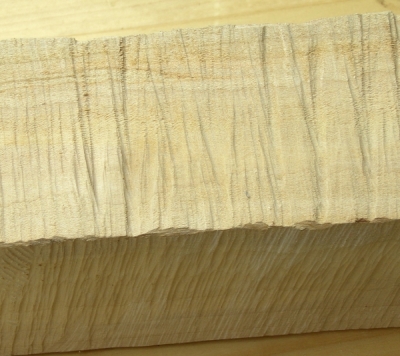 In spite of its hardness the wood is good to work with tools and machines. With sharp blades and cutting tools it can be carved, turned and profiled without difficulties. The surface is easy to stain and to polish, but it tends to fade in the sunlight.
In spite of its hardness the wood is good to work with tools and machines. With sharp blades and cutting tools it can be carved, turned and profiled without difficulties. The surface is easy to stain and to polish, but it tends to fade in the sunlight.
Page 3 of 6



